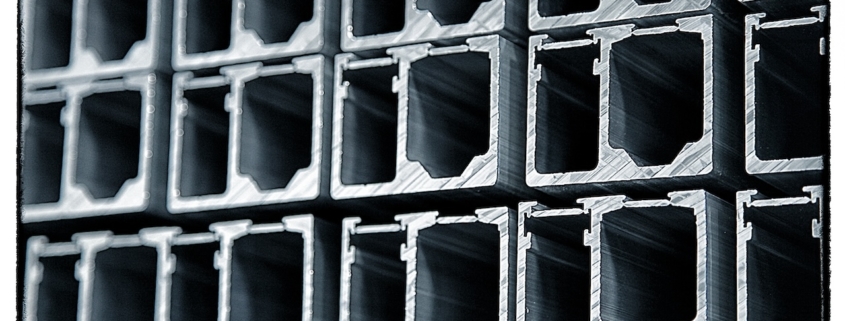How do you Design Aluminium Extrusions?
How do you Design Aluminium Extrusions?
Aluminium extrusion is a fast and cost-effective method for achieving complex cross-sectional profiles for a wide range of applications. Get the design right and aluminium extrusions can negate the need for multiple parts. What’s more, good design reduces the need for fabrication and aids the assembly of parts. So, what are our design tips?
Design Tips for Aluminium Extrusions
- Profile Size – The size of the section is limited by the container size in the extrusion press.
- Complexity – The more complex the profile, the more difficult it is to extrude.
- Uniformity of Wall Thickness – Uniformity simplifies metal flow and minimises distortion.
- Radius – Where thick-thin wall thicknesses are required, streamline with a radius.
- Symmetry of Profile – Easier to maintain the required metal thickness.
- Solid or Hollow – Hollow sections may offer a better solution
- Avoid Sharp Corners – Sharp corners restrict metal flow.
- Grooves – Deep, narrow slots or grooves should be avoided where possible.
- Tolerances – Extrusions are produced to EN755.
- Surface Finish – Clearly indicate profile visible faces.
- Design In – Screw Grooves, Bolt Slots, Clip fits and Hinges to eliminate some machining.
- Alloy – Consider the end application, do you require medium strength, high strength, conductivity, formability, high corrosion resistance, good surface finish?
The process of pushing malleable metal through a die offers considerable versatility in design. However, there are some key considerations to ensure the integrity of parts.
The starting point is the end application. It is important to consider the profile size, weight, length and the stresses that will be placed on the extruded metal. In addition, map out the assembly; how will the profile connect with other parts or materials? Do they slide or screw together, will they be mated with other parts? Then consider the required finish.
These factors inform the profile design of aluminium extrusion, from the most appropriate alloy to the required wall thicknesses. They also indicate where hollows, integrated slots, holes, threads and other details can be included to minimise end-operations.
Alterations to the design may be necessary to ensure tolerances are compliant with EN 755 standards.
If this all sounds complicated, we can translate your sketches, CAD designs and PDFs into viable profile designs. If you have already prepared a design, we advise on minor alterations to remove potential issues or lower the cost of production.
What is the Minimum Wall Thickness for Aluminium Extrusions?
The wall thickness of an aluminium extrusion is determined by the size, alloy and complexity of the shape. The wall thickness of small complex sections can be as little as 0.5mm. However, the thinner the wall and the more complex the shape, the more difficult it is to extrude.
The priority for good profile design is uniformity. This is because uniform thickness aids the even flow of metal through the die. This minimises the risk of uneven metal distribution, which can cause distortion. So, aim for minimal variation in wall thickness and use generous tapers or radii to transition between changes. In addition, good profile design favours symmetry and avoids sharp corners or points.
Our input at the design stage can resolve issues to deliver a profile that can be manufactured efficiently and deliver the desired result.
What is the Best Aluminium Alloy for Extrusion?
High purity aluminium is malleable with excellent thermal and electrical conductivity and a high shine finish. However, it lacks structural strength. For this reason, silicon, magnesium and other alloys are more commonly used for aluminium extrusions.
The alloy choice depends upon the end use, structural strength, machinability, weldability, forming characteristics and surface finish requirements of the profile. We are happy to advise.
The most commonly used alloys are from the 6000 Series; mainly 6063, 6060, 6082 and 6005. For example, we might recommend:
· 6063 for profiles requiring medium strength end use, such as architectural, partitioning and shop fitting.
· 6082 for profiles requiring high strength for structural end use, such as vehicles, bridges, cranes, and ladders.
Whichever alloy is used, all untreated aluminium will form a natural oxide film, giving adequate protection for low cost and no maintenance applications. Its initial appearance will be changed by weathering and atmospheric pollution.
The End Use of your profile will determine the end finish requirements; Mill Finish, Anodised or Powder Coated.
Profile Design Service
Aluminium is the ideal metal to meet the structural demands of parts needed across many industries. The fact that it can be extruded allows it to be formed into intricate designs for custom applications or high-volume production.
Our profile design service offers the most effective and cost-efficient solutions for your application. We are happy to advise on suitable alloys and finishes, explaining the reasoning behind our suggestions. If fabrication, assembly, finishing or stock holding are required, we will inform you of our in-house services. Get in touch to discuss your requirements at sales@salesmade.co.uk or 01296 431292.

